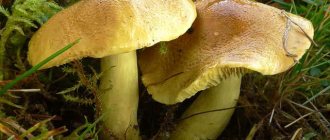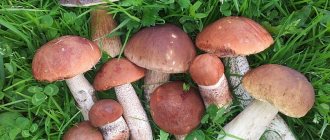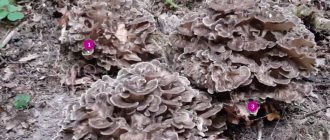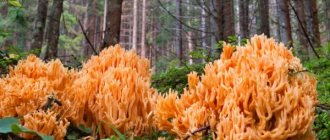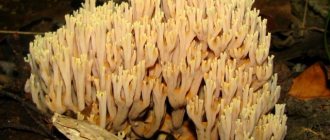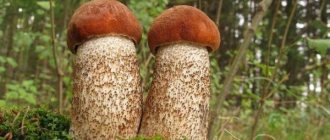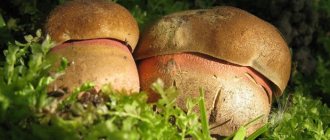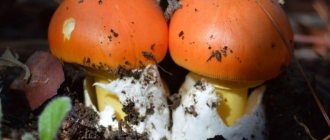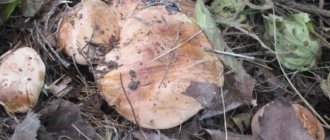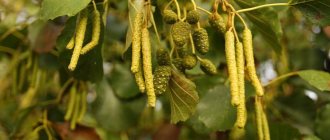The tongue mushroom is a member of the basidiomycete family and the only specimen in the genus Fistulina. Distributed in oak forests. The eucalypts of Australia are full of actively parasitic specimens. Belarus has listed the Liverwort in the Red Book. Mother-in-law's tongue is edible. Combines a number of useful properties.
It also has other names - mother-in-law's tongue, wolf's tongue, liver mushroom or simply common liverwort. Now industrial conditions will be suitable for cultivating this representative of a huge kingdom. Cultivation methods were created by Japanese fungotherapists and mycologists who cultivated this variety. Belongs to the edible fourth category. The recipes are quick and easy to prepare.
Biological description
Botanists named it Fistulina Hepatica - “hepatica”, which means “liver-like”. It is described as looking like a piece of red meat clinging to a stump or tree. The soft, veined flesh releases a blood-like juice when pressed. The liver fungus is a mildly parasitic fungus on the wood of oaks and other deciduous trees. As the fruiting body develops, it damages the tree, and when it falls off, a hollow remains at the attachment site. It grows alone or in small groups at the base of trees, as well as on stumps. Found in summer and autumn.
The mushroom can be identified by the following characteristics:
- cap - 7-20 cm in diameter, depth - 7-14 cm. The shape is irregular, often semicircular, fan-shaped or reed-shaped, with a lobed and wavy edge. After rain, its surface may be sticky, especially if it is a young mushroom. The color of the cap is liver red, reddish orange or brownish red;
- leg - absent or in a rudimentary and lateral position. Colored in the same way as the hat;
- the surface of the pores has a shade from white to pale pinkish. The hue turns yellowish and eventually reddish-brown with age. The tubes are clearly separated. Their length is up to 1.5 cm;
- the pulp is whitish, with reddish stripes, thick, soft, watery;
- smell and taste - neutral smell. The taste is sour;
- spores - size 3–4 × 2–3 µm. The shape is broadly almond-shaped. The surface is smooth, yellowish in color.
Video: Liverwort mushroom
Types of these mushrooms, appearance
In addition to the name mother-in-law's tongue, this mushroom is also called ox mushroom, bovine mushroom, meat red mushroom, wolf mushroom or common pecheritsa. This representative of the Fistulinaceae family has a large fruiting body, which over time acquires a tongue-like or leaf-like shape. Pecheritsa has a smooth, shiny surface, the color of which varies from orange to light red. The stalk of mother-in-law's tongue has a rigid structure. It is painted dark red and serves to attach the mushroom to the surface of the trees.
Liverworts also differ from other species in their hymenophores, which are represented by separate tubes. They have a beige color, which, if touched, immediately changes to yellow.
Mother-in-law's tongue mushroom has very elastic flesh that is pink in color. The dark red veins on it form a beautiful marble pattern. If this pulp is cut, the mushroom will resemble a red piece of meat or liver, which is facilitated by the release of a specific juice, similar to ichor.
Other names
The mushroom has quite a few synonymous names. In English-language literature, chestnut and oak tongue, mushroom steak, and ox tongue are found. And this is simply explained: a bright appearance evokes many associations, which are enshrined in popular names:
- bugloss;
- liverwort mushroom;
- Mother-in-law's tongue.
Mature liver mushroom stains your fingers deeply red, so wear gloves when picking it.
How to distinguish edible from inedible
Mother-in-law's tongue (mushrooms are often similar to each other) out of ignorance can very easily be confused with the bristle-haired tinder fungus. This is a very toxic species that looks almost like a liverwort, but still has its own distinctive features. These include:
- dark red (almost brown) color of the cap;
- the surface of the fruit body covered with small villi;
- brown color of the pulp;
- a fruiting body formed by several caps.
Another inedible counterpart of mother-in-law's tongue is the tuberous tinder fungus. It bears fruit all year round and differs from liverwort in its distinct woody aroma. Sources used:
- https://gribnik.info/pecenocnyj-grib/
- https://gribportal.ru/vidy/teshchin-yazyk/
- https://heaclub.ru/grib-korovnik-korovya-guba-kak-vyglyadit-svinushka-polza-i-vred-griba-sposoby-prigotovleniya-gribov-korovya-guba-chto-delat-pri-otravlenii-gribami
- https://gribnikoff.ru/vidy-gribov/sedobnye/pechyonochnitsa-obyknovennaya/
- https://ogorod-bez-hlopot.ru/opisanie-pechenochnogo-griba.html
- https://domsad.guru/griby/pic919_grib-teshhin-yazyk.html
- https://grib.guru/drugie/grib-tyoshhin-yazyik
The nutritional value
The nutritional value of Fistulina Hepatica lies in the large range of vitamins and minerals that are included in its composition. But the exact values depend on the area in which it grows and what microelements the soil is saturated with.
In any case, it remains a biologically active product that has the ability to inhibit (suspend) the growth of tumor cells. Due to the combination of high antitumor activity and a set of natural compounds, it is a promising antitumor agent that deserves further laboratory study.
Distribution and collection time
Liverwort is usually harvested in mid-summer. But it can also be grown at home, so Fistulina Hepatica can grow in farms at other times of the year. Oak logs and nutrient substrate are used for cultivation.
Did you know? No one knows how many species of mushrooms actually exist in nature.
Today there are more than 10,000 described species, but all mycologists agree that there are many more in the wild that have not yet been described.
Beneficial features
The mushroom contains a large amount of trace elements such as potassium and phosphorus. It is an excellent source of B vitamins, vitamin D and a number of antioxidants. The latter reduce the risk of certain types of cancer and inflammatory processes. It contains a lot of beta-glucans - substances that lower cholesterol levels. The dry mass of the mushroom contains about 30% protein, and this is much more than in steak.
Moreover, this is a product that contains the most complete set of protein compounds - essential amino acids. And this makes it a source of super proteins. It also contains soluble and insoluble fiber. They improve gut health and help lower cholesterol levels.
Important! Ox tongue is best collected when it is young. It will be softer and more pliable in cooking.
Liver mushroom is absolutely safe. Its pulp was considered an alternative to meat food, as it is similar to liver. Liverwort has many beneficial properties. Its rich taste with notes of green tomatoes and good weight make it an ideal product for preparing vegetarian dishes. It is also interesting for gourmets. They can prepare it in many ways: marinate, fry, boil, all the time being in search of a new and unusual culinary experience.
Mushrooms are a great way to increase the amount of organic, healthy food in your diet. Liver mushroom is often eaten raw due to its sour, sorrel-like taste. It is an excellent ingredient for summer mushroom salads. But it can also be used in risotto, pies, soups, or simply roasted for toast with a little garlic. Liverwort can be consumed in any form.
- Medicinal properties:
- The mushroom is one of the few whose antioxidant properties have been proven.
- The Italian scientist Coletto also proved that Fistulina Hepatica has a very strong antibacterial effect against various pathogenic bacteria such as Escherichia coli, Staphylococcus aureus, Bacillus subtilis, Klebsiella pneumoniae.
Video: Description of the common liverwort
“Mother-in-law’s tongue,” in Korean, like mushrooms and jam. 5 recipes for zucchini preparations for the winter
Perhaps not all of these methods of preserving zucchini were known to you, but we hope that the finished dishes will not disappoint.
Zucchini "mother-in-law's tongue"
Product Composition
- peeled zucchini - 2 kg;
- tomatoes - 1.5 kg;
- carrots - 500 g;
- large bell pepper - 2 pcs.;
- hot pepper - 1 pc.;
- peeled garlic - 100 g;
- sugar - 200 g;
- salt - 2 table. spoons;
- vegetable oil and vinegar (9%) - 140 ml each.
Cooking method
Cut the zucchini into small cubes.
Remove the stems from the tomatoes and cut them into 4 pieces. Pass through a meat grinder along with sweet pepper.
Three carrots on a medium grater. Fry in vegetable oil for about 5 minutes.
Place the tomatoes and peppers in a deep saucepan on the fire and bring to a boil. Add carrots, sugar, salt here. Let the mixture boil, then add the zucchini to the tomato dressing.
Simmer until the zucchini is ready - they should be slightly dense. Add chopped garlic and hot pepper to the salad. Cook for 5 minutes and add vinegar. Boil for another minute.
Fill sterilized jars with salad. We roll it up and wrap it up.
Zucchini like mushrooms
Product Composition
- zucchini - 2 kg;
- carrots - 2 pcs.;
- garlic - 8 cloves;
- parsley and dill;
- salt - 2 table. spoons;
- sugar - 4 table. spoons;
- ground black pepper - ¼ teaspoon;
- 6 tables each. spoons of vinegar (9%) and vegetable oil.
Cooking method
Remove the skin from the zucchini and cut them into cubes.
Peel the carrots and cut into strips or slices.
Chop the greens and garlic.
Place everything in one large bowl, add pepper, salt, sugar, vinegar, vegetable oil, mix well and leave to marinate for 4 hours. The mixture must be stirred periodically so that the vegetables are evenly soaked.
Place the pickled mixture in sterilized jars and cover with lids.
Place the preserves in a deep saucepan with a towel on the bottom. Fill the pan with cold water up to the shoulders of the jar, bring to a boil and sterilize over low heat for 20 minutes (0.5 liter jar).
We roll it up and wrap it up.
Korean zucchini
Product Composition
- zucchini - 2.5 kg;
- sweet pepper - 0.2 kg;
- carrots - 0.5 kg;
- onions - 0.3 kg;
- dill and parsley - 100 g;
- garlic - 8 cloves.
To fill, prepare:
- refined vegetable oil - 200 ml;
- sugar - 4 table. spoons;
- salt - 2 table. spoons;
- vinegar (9%) - 10 table. spoon;
- ground red pepper - ½ tsp;
- seasoning for carrots in Korean - 2 tablespoons. spoons.
Cooking method
It is necessary to cut into strips or grate zucchini and carrots for Korean carrots.
Cut the onion and pepper into thin half rings.
Chop the greens.
Place everything in one large bowl or pan.
Separately mix all the ingredients for the marinade, add garlic.
Combine the filling with the vegetables, mix well and leave to marinate for 3 hours, stirring occasionally.
Divide the vegetable mixture into sterilized jars.
Sterilize for 20 minutes (0.5 jars) or 30 minutes (1 liter container).
Roll up, wrap up.
Zucchini marinated with tomatoes
Product Composition
(for a 3-liter jar)
- zucchini (not overripe);
- tomatoes;
- 2 dill umbrellas;
- 2 bay leaves;
- 3 cloves of garlic;
- black peppercorns - 10 pcs.;
- allspice peas - 3 pcs.;
- vinegar (9%) - 3 tablespoons. spoons.
To fill you need to take 2 tables. spoons (heaped) of salt and 3 tbsp. spoons of sugar for every 1.5 liters of water.
Cooking method
Peel the zucchini.
Cut out the stems of the tomatoes.
Place spices and garlic at the bottom of a sterilized jar.
Add zucchini to the container, alternating them with tomatoes.
Pour boiling marinade, cover with a sterilized lid and place in boiling water to sterilize for 30 minutes.
After this, take out the jar and pour vinegar into it.
Roll it up, turn it over, wrap it up.
5. Jam
Product Composition
- 1 kg each of peeled zucchini and sugar;
- 0.5 glasses of water;
- 1 lemon.
Cooking method
Peel the zucchini and cut into cubes.
Cover the zucchini with sugar, add water and put on fire.
Bring to a boil and cook for 20 minutes, stirring occasionally.
Chop the lemon very finely along with the zest and add to the jam. Cook the zucchini jam with lemon for another 30 minutes until the syrup thickens.
Pour the finished zucchini jam into sterile jars. Roll up and cover for additional sterilization.
Useful Tricks
1. For preparations, it is better to take young zucchini.
2. Marinade for zucchini for the winter must contain acid - acetic, citric. After all, the vegetables themselves practically do not contain this component, important for preservation, and will not be stored without a sufficient amount of it.
3.
As for the heat treatment of workpieces, there are also several rules here - jars for sterilization (heating at 100 ° C) and pasteurization (warming at 85–95 degrees) must be placed in water at the same temperature as the contents in them. Otherwise the glass may burst. Be sure to place a napkin (towel) at the bottom of the pan. And add enough water to cover the “hangers” of the jar.
4. Vinegar and spices should not be subjected to prolonged heat treatment, so as not to deteriorate the quality of the marinade.
5. Herbs (dry, fresh) should be doused with boiling water before adding to the jar and be sure to place them at the bottom of the vessel.
Source
Source: https://esp.md/kaleydoskop/2020/08/02/tyoshchin-yazyk-po-koreyski-kak-griby-i-varene-5-receptov-zagotovok-na-zimu
Contraindications
Liver mushroom has no contraindications and can be used by both adults and children. For young women who are breastfeeding or pregnant, there is little reliable information about the safety of mushroom consumption in general. Therefore, if you have not used one or another of them before, then it is better to abstain, at least until the baby is six months old. By this time, his stomach will be more able to tolerate innovations in his mother’s diet.
You might be interested in learning how to grow champignons in a greenhouse.
Mushrooms are excellent sources of protein, fiber, B vitamins (especially niacin), vitamin C, calcium, minerals and selenium. They also contain antioxidants and many other beneficial substances. Collect them starting in the second half of summer, cook them, eat them fried or raw and strengthen your body thanks to their nutritional and medicinal properties.
Edibility of Plutea
Among the edible species, the most famous are the deer spittle, although it is collected quite rarely, the umber spittle, and the dark-edged spittle. The inedible ones include the velvety-footed plover and the noble plute. Some of the species are described as little-known edible mushrooms, for example, dwarf pluteus, veined pluteus. Species for which nutritional properties have not been studied are traditionally classified as inedible.
Despite its popularity, the edible spud is characterized by a pleasant, sweetish taste and smell, reminiscent of potatoes. The tender and fleshy pulp of these mushrooms perfectly retains its properties when dried, fried and boiled. In traditional dishes of the northern peoples, plute is used even in its raw form.
Young mushrooms are eaten. Mature plume acquires a peculiar sourish taste, which is not hazardous to health, but spoils the nutritional quality of the food.
